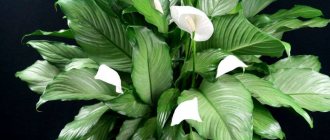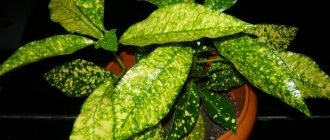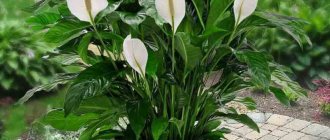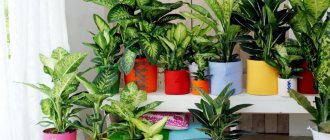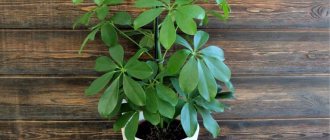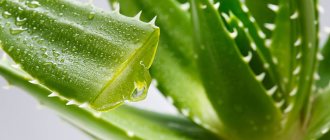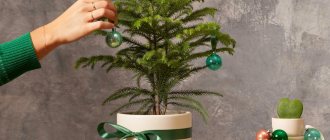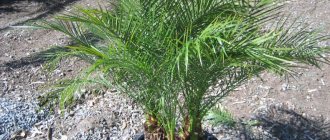According to legend, it attracts prosperity to its owner. For which he quickly received popular love. But I fell in love with it for its eccentric, graceful appearance and long-lasting flowering. The plant will delight you with delicate flowers with a delicate aroma from March to September. If he likes the conditions, he will continue in the winter. Proven fact: copes with air purification at 5+. Ideal for use in creative studios, kitchens and bathrooms. Fits like a glove into a Scandinavian interior. Although it harmonizes with other styles. The main thing is complete care. Fortunately, this is an easy process.
General information about the plant
Spathiphyllum in its natural habitat
- Bloom. The beginning of spathiphyllum flowering is the first ten days of March. The total flowering time can be up to 6 months. In rare cases, the plant blooms until the end of autumn.
- Illumination. Diffuse lighting is required. The plant has enough daylight and does not need additional lighting with lamps.
- Temperature conditions. Under normal conditions, the temperature should be maintained between 23°C and 32°C. During the dormant period and to stimulate flowering, the plant needs lower temperatures - optimal from 17°C to 20°C.
- Watering. Regular watering once every 2 days. During the rest period - once a week.
- Air humidity. In the room with the plant there should be at least 80%. Important! This is a critical indicator for culture.
- Fertilizers. Use mineral fertilizer for aroid crops at a concentration of 1 g per 1 liter of water. It is recommended to alternate it with mullein solution (30-40 g per 1 liter of water). Nutrients are added once a week.
- Rest period. From October to January. Temperature not lower than 16 degrees Celsius.
- Transfer. Produced once every 3-5 years in a pot of larger diameter. A sign of need - the roots begin to protrude from the ground, the sockets do not sit tightly in the ground.
- Necessary soil. A mixture of turf soil, leaf soil, peat and coarse sand in a ratio of 1:1:2:1.
- Reproduction. Can be propagated by seeds, cuttings, or dividing the bush.
- Pests. Aphids, spider mites, thrips, scale insects.
- Diseases. Root rot, leaf spot, chlorosis, gommosis.
Beautiful inflorescence
Types, names with photos
Spathiphyllum Charming / Spathiphyllum Blandum
View from the tropical mainland of South America. For the shape of the flower, reminiscent of a flag, it is nicknamed “flagolith” by local residents. The leaves are elongated, lanceolate, dark green in color. The flower's cover is white and light green.
Spathiphyllum Cannifolium
This species is found in Thailand and Venezuela. The leaves are oval shaped and bright green in color. Pale light green flowers exude a pleasant scent.
Spathiphyllum Wallisii
Columbia flower with lanceolate green foliage. The petal blanket tends to change color from white to pale green during flowering.
Spathiphyllum Spoon-shaped / Spathiphyllum Cochlearispathum
The plant is native to the Brazilian rainforest. An adult bush can grow up to one meter in height. Large leaves (40x20 centimeters) on high petioles, dark green, lanceolate in shape with wavy edges. Both the spadix and the petal spathe are white.
Spathiphyllum floribundum
This type of spathiphyllum is found in Colombia. The plant has bright green, oval foliage of medium size (25x15 centimeters). The flower's cover is white.
Spathiphyllum heliconiifolium
A meter long lush bush from Brazil. The leaf blade is ellipsoidal in shape, with wavy edges and a sharp tip. The leaves are quite large (50x25 centimeters), dark green in color. The blanket petal changes color from white to black as it blooms.
Spathiphyllum care
The plant is very easy to care for and does not require any specific methods or means to maintain itself in good shape. Timely watering, fertilizing and replanting of the plant guarantee an excellent flower life at home.
Requirements for climate and containers during cultivation
Under natural conditions, spathiphyllum lives on the lowest tier of plants in the tropics and subtropical forests; bright sunlight is contraindicated for him.
Direct sunlight on spathiphyllum causes burns to the plant. This mistake is often made by beginners or inexperienced gardeners.
Therefore, the best place for spathiphyllum is in the house on the east-facing windows. In summer, the plant needs to be shaded or provided with diffused lighting. This can be done using blinds, film or plain paper. The wrong approach is to completely shade the flower; this is only permissible for a few varieties of spathiphyllum.
On a shaded windowsill
But complete shading is undesirable, since the flowering period of spathiphyllum is reduced by almost half. On the contrary, increasing the duration of daylight hours prolongs the flowering time and is one of the conditions for the onset of its repeated cycle.
It is not advisable to achieve two blooms per season, since the next year the plant may not bloom at all. Even with a relatively small amount of light, spathiphyllum blooms for almost two months.
The plant does not like drafts and cooling of its root system. It is advisable to place the pot on the windowsill for the winter on a foam “bedding” with a thickness of at least 15 mm.
One of the main requirements for spathiphyllum is moist air. Dry air is detrimental to the plant.
Spathiphyllum in conditions of high air humidity
The pot with spathiphyllum should be removed from various heaters (heaters, air heaters, fan heaters, etc.), and its leaves should receive regular moisture. When air humidity is 80-90% in summer and 80-70% in winter, this is not necessary.
You can prepare the soil by moving away from the previously indicated soil composition. Instead of sand, it is permissible to use perlite, and instead of peat - humus, compost or a purchased substrate for orchids. The use of sphagnum has proven well. There are only two main requirements for soil : sufficient fertility and loose consistency.
To prevent water from stagnating, you need to make 3-4 additional holes in the bottom and use drainage from medium-sized pebbles : expanded clay, pieces of crushed stone, brick chips or pebbles. The height of the drainage is a quarter of the height of the container.
This is what drainage for a flower looks like, laid at the bottom of the container.
Watering the plant
For irrigation, use water at room temperature, standing for 2-3 days. Watering spathiphyllum is difficult to regulate, indicating certain deadlines. Everything should be done based on necessity.
Watering is done as the lump of earth in the pot dries out. This can be determined by the dryness of the top layer of soil, or by the condition of the plant. If the leaves of the plant “wither” a little, it’s time to water it.
Wilted leaves indicate the need for watering
In autumn and summer, watering is done abundantly. Starting from October, its volume should be gradually reduced. On average, in winter the amount of water that is used to water a flower is half as much as in summer . Half an hour after watering, the pan is emptied of excess liquid.
Recommended watering times may be:
- summer: no more than once every three days;
- spring and autumn: once every 4-5 days;
- winter: once a week.
The plant can quickly die without moisture; on the other hand, waterlogging should also not be allowed. It is forbidden to quickly change the irrigation scheme. The transition from summer to winter watering mode is not allowed immediately!
Spathiphyllum fertilizer
The secret to success in growing spathiphyllum is the correct use of fertilizers. They are introduced during the active growing season of the plant, which lasts from late March to early September. The frequency of fertilizing is 1.5-2 times a month. This will be enough for the flower to bloom. Additional nutrition is introduced mainly by the root method. It is best to fertilize spathiphyllum in the first half of the day.
During the dormant period (November - February), fertilizing is not recommended. If the plant continues to grow actively, the feeding schedule is adjusted - the flower can be fed once a month.
It is recommended to use ready-made universal complex mixtures purchased at flower shops as fertilizers. Their main component is azofoska, containing phosphorus, potassium and nitrogen. These products also contain magnesium and boron.
The concentration of purchased fertilizers should be approximately 1-2 g per liter of water. For a greater variety of microelements, it is recommended to alternate feeding with mineral complexes and liquid organic fertilizers. The concentration of organic matter should be significantly higher (infusion of 30 grams or more of mullein or 15 g of chicken manure per 1 liter of water).
An alternative fertilizer is yeast; in addition, such bait is used to prevent fungal diseases of the root system.
For this you will need:
- 1 teaspoon dry yeast;
- 1 tablespoon sugar.
The components are mixed, pour 1 liter of water and leave for several hours, then the concentrate is diluted with water in a ratio of 1 to 5. The resulting mixture can be fed to the flower, using it for watering.
For young plants (up to 3 years), succinic acid is used, which is a growth stimulator. To prepare the fertilizer, use 1 tablet of acid diluted in a liter of water. A similar effect is produced by whey diluted in water in a ratio of 1 to 10.
Sometimes folk recipes and remedies are used for fertilizer, for example, tea leaves. When dry, it is scattered over the surface of the pot. Dried coffee grounds have the same effect. Another alternative fertilizer is banana peels. It is dried in the oven, crushed and the resulting powder is added to the top layer of soil.
Transplanting a plant
Spathiphyllum should be replanted annually for plants between 1 and 5 years old. Plants older than five years are replanted only as needed, when the root system begins to emerge from the ground.
The pot for the plant should not be too large so that the roots have time to grow sufficiently before the substrate loses its fertile qualities.
The diameter of the pot is chosen to be half the diameter of the circumference of the leaves of the plant. In the first five years of a flower’s life, the following rule must be followed: each subsequent pot should be 2-3 cm larger in diameter than the previous one. To grow spathiphyllum, both plastic and clay containers are suitable. Transplantation is carried out very carefully, preferably using the transshipment method. Before this, the soil is slightly moistened.
As soon as the diameter of the pot exceeds 20-22 cm, replanting is either stopped, dividing the root system and actually turning one mother plant into several daughter plants, or simply changing the top layer of the soil mixture.
Transplantation is carried out in the spring, no later than May. Before removing the plant from the pot, it should be watered thoroughly to make it easier to work with. It is not necessary to completely clean the substrate from the roots; moreover, it is advisable to leave a medium-sized earthen ball on the roots.
Spathiphyllum in need of transplantation
During the replanting process, it is recommended to remove the lateral shoots of the plant so that they do not interfere with the main leaves. An additional stimulation of growth and flowering will be pruning old leaves. You need to pour 1.2-2 cm of fresh soil mixture onto the drainage layer in the new pot and place an earthen ball of the plant on it.
After this, the remaining soil is added and lightly compacted. There is no need to pour in excess soil: it should not reach at least 2 cm to the top edge of the hill. This is followed by a little watering and the plant must be left alone for several hours.
For a week after transplantation, the plant is not watered at all, however, it requires twice (every 2-3 days) spraying with water with the addition of a few drops of growth stimulant - Epin . This will allow him to quickly adapt his root system to the new soil. A few days after the second spraying, watering is resumed.
Indoor plants for family happiness and well-being
If you don't have indoor plants, today is the time to get them. After all, this is not just a decoration growing modestly on a windowsill, or a mini-factory for converting light energy into oxygen. These are living beings! Experienced flower growers know that correctly selected home flowers will become a lucky talisman in your life and bring prosperity to your home.
Favorable indoor flowers
Today World of Travel will tell you about favorable indoor flowers , which are not only very beautiful, but also have special positive energy.
Spathiphyllum
This plant gives its owner real feminine happiness! Spathiphyllum fulfills wishes and helps unmarried people find love. Bring this plant into your home, and there will always be love and mutual understanding . But don’t forget to change the soil in the pot once a year and spray the flower with fresh water every day. Saintpaulia
It is also called the Uzambara violet and a symbol of eternal love . The flower protects against illness and failure, helps improve family relationships and peacefully resolve conflicts. But for Saintpaulia to help you, it needs to be placed in a secluded place on the windowsill and hidden from prying eyes. Hibiscus
The Chinese rose kindles passion between spouses, and the fading flower takes on misfortunes. The plant loves warmth, it would be good to place it in the bedroom where there are no drafts. Wax ivy (hoya)
This plant has unusual buds with a very strong aroma. The flower pacifies envious people and creates a sense of security in the family. When the hoya is about to bloom, it should never be moved or turned over. The plant will drop its buds and will not bloom. Myrtle
The name itself symbolizes silence, peace, pleasure, love and good deeds. In ancient times, myrtle was the favorite flower of the goddess Aphrodite. In order for the myrtle to grow and “work” to its full potential, it must be planted by the woman - the mistress of the house. Then the marriage will be long and successful. Aichrizon
This homemade succulent is called the tree of love and happiness. The flower strengthens the love union and is an indicator of the relationship between spouses. If the plant develops well, blooms and produces fresh leaves, then there is harmony and love in the house. Calathea
Improves health, attracts wealth and helps fight negative energy. This flower is a real absorber of aggression! In a house where calathea grows, there will never be quarrels. Chlorophytum
The most famous plant for family happiness. If you have no personal life, problems at work, depression, urgently get this unpretentious flower. Chlorophytum relieves tense situations and helps improve relationships between household members. Oxalis
Oxalis leaves resemble butterflies and open towards the sun every morning. The plant is popularly called the flower of happiness (clover of happiness), or the flower of love. As soon as sorrel appears in the apartment, in your personal life disappear Married couples are improving their relationships, and single women have a man on the horizon. Anthurium
Although the plant is considered poisonous, its energy strengthens masculine strength , and with it success in love. Due to its unusual appearance, the plant is considered a symbol of temptation and passion. If family life has become boring, bring an elegant red anthurium into the bedroom! Cyclamen
This flower stimulates the growth of feminine energy and helps when feelings fade away. You need to buy this plant to finally find your love! Amaryllis
Strengthens the feelings and energy of the heart. The flower softens a cold mind , allows its owners to remember love, romance and forget about the harsh everyday life.
Flowers in the house are wonderful! Approach their choice with special care, and there will always be happiness, harmony and well-being in the house.
Write to us in the comments which indoor flowers with beneficial energy grow in your apartment, and which ones should be abandoned?
Be sure to tell your friends on social networks which indoor flowers are good for your home and family .
Plant propagation
Spathiphyllum reproduces in various ways. Vegetative propagation is more effective because it provides a larger amount of planting material.
Cuttings
Spathiphyllum has no stem as such, and the leaves grow directly from the rhizome and form a kind of bush. Their height ranges from 12 cm to 1.1 meters. Therefore, flower cuttings are formed from leaf rosettes separated from an adult plant. Usually, they already have roots, so they can be planted in a new place immediately after preparation.
If there are no roots on the outlet, they need to be placed in an activated carbon solution (2 tablets per 1 liter of water) for 1-2 weeks. During this time, roots several centimeters long will grow from the rosette, and the cutting can be planted in the substrate. No additional funds are required to root them.
There is no need to create a mini-greenhouse or greenhouse (in the form of a jar or plastic bottle), since cuttings can be grown in the same conditions as adult plants, they take root well.
Dividing the bush
A method ideal for old, overgrown bushes that require rejuvenation. After dividing the root system of the mother plant into several parts, each daughter plant is planted in a separate container with ordinary soil, the composition of which is similar. It is best to plant cuttings in the spring. Manipulations with the soil mixture are repeated as previously discussed for replanting.
The further care procedure is standard: after the plants are planted, water, spray with Epin solution twice a week, resume watering, etc.
Root division during propagation
Seed propagation
This method is rarely used, since spathiphyllum seeds cannot achieve germination acceptable for propagation. There are also serious difficulties with pollination of the plant. In addition, spathiphyllum seeds have a very short lifespan and must be sown in the ground almost immediately after they fall from the inflorescence.
The idea of propagating spathiphyllum by seeds is justified exclusively in selective cultivation.
The balsam flower should be renewed by cuttings every 2 years.
- Impatiens family joy can be propagated by seeds.
- Seeds germinate under the influence of light, so the ground should not be covered with an opaque film.
- In flowerbeds in the garden, balsam looks especially attractive.
- Due to the fact that the stems are very fragile, the flower should be handled very carefully.
- To prevent the roots from becoming moldy, do not allow water to stagnate.
- Moisten the soil, but moderately.
- Do not spray the flower.
- Keep an eye on the plant after feeding.
- If the leaves change color and begin to curl, then the fertilizer should be diluted well with water.
- Like the royal geranium, it likes a tight and compact pot.
- In a hanging pot it looks spectacular and amazing.
[/su_list]
Diseases and pests
Let's look at the most common problems that can arise with a plant and describe methods for dealing with them.
Diseases
The list of diseases was given earlier. For convenience, their symptoms and treatment methods are presented in table form.
Greening of the petals of the flowering part is not a disease. This is a natural color change at the end of the flowering period.
Blackening of leaves due to gommosis
After this, it is necessary to remove all rotten roots, prepare a new substrate and transplant the plant into a pot with an updated drainage system. This is followed by the standard procedure for reducing watering and treating the plant with epin, described earlier.
Pests
Spathiphyllum has few of them. The main problem for the plant is spider mites and aphids. If representatives of a large colony of these creatures begin to drink the juices of the plant, and continue to do so for 2-3 days, the plant may become sick.
To prevent negative consequences for the flower, it must be carefully examined every day. Inspection must also be carried out on the inside of the leaves.
An effective remedy against these arthropods is a soap solution to which a few drops of nicotine sulfate are added.
Spider mites are the main pest of spathiphyllum
Before treating leaves affected by pests, it is recommended to cover the soil with plastic film. The drug is applied to the leaves and washed off with water after a day. The film is then removed.
As a preventive measure against insects, you can wipe the leaves of the plant once a month using one soap solution, without any additives. The primer is not covered, but the soap solution is removed immediately after its application using a damp cloth or sponge.
Scale insects infect the plant less frequently, but controlling them is more difficult. In the early stages of the lesion, it is recommended to use the previously described solution of soap and nicotine sulfate. If adult scale insects have settled on the plant, in order not to damage the flower, they will have to be removed mechanically using a cotton pad soaked in kerosene or alcohol.
Adult scale insects on the leaf surface
Another effective remedy is an oil-garlic solution. To prepare it you will need:
- water – 1 l;
- olive oil – 100 ml;
- garlic juice from 3 cloves.
The resulting preparation is applied to the leaves daily for 10 days. In this case, the room is ventilated twice a day. The duration of ventilation is no more than 30 minutes.
If the solution does not help, spray with Confidor or Aktara.
To combat other parasites, for example, thrips, Actellik or Fitoverm have proven themselves well. Mealybugs will also require the application of a powerful insecticide or acaricide. In order not to harm the plant, be sure to follow the dosage specified by the manufacturer.
Varieties of spathiphyllum
There are several dozen varieties of the plant. Below are the most popular varieties with a brief description and photo.
Spathiphyllum Wallis
Spathiphyllum Wallis Another name for the variety is White Sail. This is the most common subspecies in indoor cultivation. It differs from others in its smaller size: height 20-30 cm, leaves 25 by 6 cm. The edges of the leaves are wavy.
Due to the lateral veins pressed into the surface of the sheet, they have a folded appearance. The bedspread is snow-white. It has several varietal varieties: Cladius, Chopin, Macho, etc.
Spathiphyllum Sensation (Sensation)
Spathiphyllum Sensation (Sensation) Also a popular variety in floriculture. It belongs to large varieties, reaching a height of more than 90 cm. The leaf blades can be very large: length 50-80 cm, width 30-40 cm. The ribbing is clearly visible on the glossy leaves.
The variety is shade-loving; in the sun, the white color of the petal quickly gives way to green, but flowering still continues. In total it can last up to 10 weeks.
Spathiphyllum Picasso
Spathiphyllum Picasso This hybrid was developed from Spathiphyllum Wallis in the Netherlands. The size of the plant is slightly larger than that of its ancestor: height 40-50 cm, leaves 18-23 cm. The outside of the leaf peel is glossy, the shape of the plates is pointed. In some ways its leaves resemble the leaves of dracaena.
A special feature of the hybrid is its color - a combination of bright green and whitish areas. The root system, unlike other varieties, is compact, which allows the use of smaller containers. Popular varieties are Domino and Variegated.
Spathiphyllum profusely blooming
Spathiphyllum profusely flowering The crop is of medium height (30-60 cm), the length of the leaves is no more than 25 cm, the width is about 12 cm. The surface of the leaves is slightly rough, with clearly visible veins. Flowering is relatively mild - it begins in April and lasts about two months, but the number of flowers is large.
This is partly due to the peculiarity of the root system, which is a long stem with a large number of internodes, forming many leaves and buds.
Spathiphyllum spoon-shaped
Spathiphyllum spoon-shaped Latin name Spathiphyllum cochlearispathum. Tall variety, reaching up to 1 m in height. Peduncles can reach 1.2 m. The leaves are large and elongated. Their size is from 30 to 40 cm, the height of the petiole is about 70 cm.
A special feature is the inflorescence in the shape of a thick cob, changing its color from bright yellow to black. At the same time, the bedspread does not change its color.
Spathiphyllum cannofolia
Spathiphyllum cannifolium Latin name - Spathiphyllum cannifolium. Due to the interesting shape of the leaves, this subspecies is highly decorative even without flowering. The length of the leaves of this variety reaches 50 cm. They are located on long petioles that widen towards the bottom.
Flowering lasts from April to June. It is possible to re-bloom at the beginning of winter using additional illumination with phytolamps. The inflorescence is thin and long, the spathe is relatively small. Its color is white on one side and white-green on the other side.
Spathiphyllum charming
Spathiphyllum lovely is a hybrid of medium height, with leaves 25-35 cm long and a petiole up to 40 cm. A special feature of the structure of the flower is a greenish color, almost the same as the leaves. Heat-loving. It tolerates drafts and temperature changes very poorly.
Does not like watering with cold water. Grows on slightly acidic soils. If the soil becomes alkaline, unsightly white spots will appear on the leaves.
Mr. Summer Resident advises: Spathiphyllum is a flower of female happiness
Spathiphyllum has several names at the same time - peace lily, white sail, women's happiness, but the last one is considered the most common option. There is an opinion that this plant has great magical powers.
With high-quality care for the peace lily, it will thank its owner by giving her joy, happiness and peace of mind. These flowers increase self-esteem, improve health, and allow you to find harmony with yourself and the outside world.
There are even several signs associated with this plant:
- if a lonely woman is given this flower, she will soon meet her true love;
- in the absence of children, it allows you to feel the happiness of motherhood;
- improves harmony in relationships.
They enhance the effect of spathiphyllum by purchasing male happiness - anthurium. The combination of these colors will ensure true harmony, romance and mutual understanding in the family.

